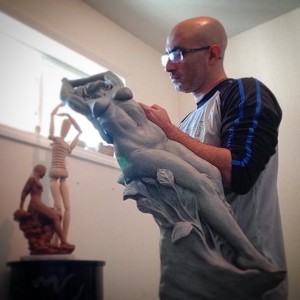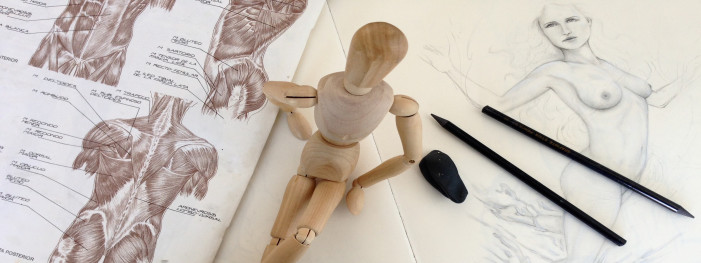Studio Time Without Studio Space

Many people hate Monday. I like Monday. Monday is my studio day, or at least it used to be. Technically it still is but certain things changed since we moved. I no longer have a dedicated studio space. The studio space was that corner in which I could work on my art without restrictions and where people came to take private lessons. It was also my space to think, plan, and generate ideas for current and future work. Not having that space sounds like a terrible loss, but it is not. I can have studio time without studio space.
Discipline and practice is not limited to a physical space but to the actions required to maintain the habits to continue creating and improving technique. Yes, the space is necessary to expand those creative moments, teach, keep supplies, and being able to come back to the work at any time. I feel like I’m taking a sabbatical from sculpting and painting. Nonetheless, I keep myself busy drawing everyday, and I am doing the painting and sculpting parties more frequently too. Now that I am writing again that also keeps my mind busy and gives me the chance to meditate and articulate ideas and my mental process. I’ll be teaching a computer class soon as well. Beginning next school semester I’ll be teaching in a university too. With all of these things happening at once I have to consider the world my studio.
I don’t think there is a need to limit myself to the physical studio space to dance with muses and get ready for what comes next. I don’t want to have a studio space as I had before. I want something else for which I’m getting ready. As the weather gets warmer I will be painting outside more, and who knows, maybe I’ll be sculpting again soon. That I can do while I wait to understand God’s will regarding studio space where I can display my art, work, and teach. Until then I enjoy studio time every day. Everything will come to pass in due time. There are so many things to look forward to this year.
Read also Studio Time: Work on Something or Nothing & The Discipline in The Discipline



 It is that time of the year! Many are figuring out their new year resolutions and goals. The desire of making something different for a new year is very common. We know most of them are carrying on from previous years. We also know that desiring to do something is not enough. Resolutions are decisions or determinations to accomplish something. Action is required.
It is that time of the year! Many are figuring out their new year resolutions and goals. The desire of making something different for a new year is very common. We know most of them are carrying on from previous years. We also know that desiring to do something is not enough. Resolutions are decisions or determinations to accomplish something. Action is required.
The Three Questions
The first question “Why?” establishes conscience of the status quo and questions it. We get used to the status quo and continue living in it without taking time to ask ourselves “why are we doing this?” or “why are we doing this way?”. We can question the question itself. Without questioning the status quo we can’t perceive the possibilities of change and there is where the second question comes into place. “What if?” paints a picture of a desired scenario. “What if things were different?” “What if we could change what we have now to what we need?” We can think of opportunities for change with that question. Of course, we need a bridge between the current and the preferred scenario.
We can’t stop at dreaming of a different situation. It is necessary to move into action. Many won’t get pass the “What if?” but some will. “How?” is the process of connecting the “Why?” and the “What if?”. Here is where change happens. It is a process and it requires effort and hard work. That is why many don’t cross the bridge. Those who dare to cross the bridge achieve the realization of their dream.
June is here with new opportunities to question and start crossing the bridge. We get that opportunity each day. I want to invite you to give yourself a chance and try something different. Check out the sculpting and painting parties. It will help you disconnect to connect back and change your perspective on challenge and these parties are a lot of fun too. I want to invite you to also join the conversation Wednesday, June 3 for a live chat broadcast of the Creative Chat Cafe. You might find something inspiring and motivating to make your way across the bridge.